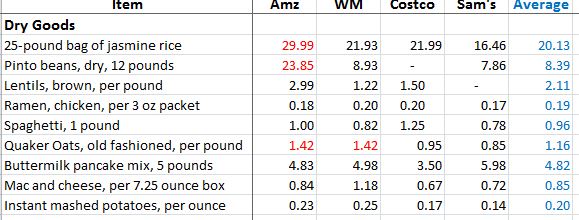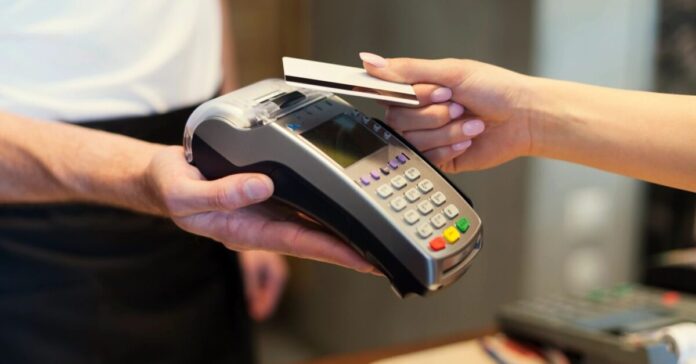Back in January, we established a basket of goods that a prepper might buy when they were stocking up. This contained common prepper foods like Spam and Tuna, baking goods like flour and yeast, rice and beans, and noodles, including ramen and mac and cheese. We shopped at four stores online: Amazon.com, Walmart.com, Costoco.com, and SamsClub.com. Our plan was to shop the same items at the same stores to determine how inflation has affected the Prepper Food Basket.
When we compare prices collected yesterday, May 8, with those collected on January 24, 15 weeks ago, the average prepper shopping basket price dropped 9 cents, from $75.42 to $75.33, a decrease of less than 1 percent. Not the inflation we were expecting to see. (Not we detected and corrected an error in our original data. The $75.42 reflects that correction.)
The average price of individual items, however, varied considerably. For example, Quaker Oats jumped 32 percent, due to a price increase at Sam’s club, while chicken-flavored ramen dropped by 42 percent, due to prices normalizing at Amazon.com and Walmart.com
How much you save depends very much on where you shop. At Sam’s Club, which had everything available except lentils, the prepper Shopping Basket cost only $66.70. At Walmart, it was $86.52, and it was $115.15 at Amazon.com Nevertheless, all three carts were lower than they were in January. (Costco was out of stock of so many items in January that we cannot compare their costs.)
Conclusions
This data leads me to conclude that large, high-volume retail outlets like Walmart, Amazon and the big club stores have successfully managed their suppliers and keep prices steady. Perhaps food inflation is still coming, as companies like Heinz and Proctor and Gamble are just rolling out price increases.
This report also seems to show that supply and demand disparities are lessening. For example, multiple items that were unavailable on Costcos.com in January are now back in stock. For example, spaghetti, ramen, lentils, pure vanilla extract, and condensed chicken noodle soup are all available at Costco.com today but were not in January
High prices at Amazon.com, often caused because most sellers are sold out, have also moderated, even though buying our basket of goods there still costs 72 percent more than at Sam’s Club.
Fossil Fuels up 13 Percent
While the food prices have stayed constant, the same cannot be said of gasoline, diesel, home heating oil and propane. Unleaded gas is up 22 percent while diesel has risen 14 percent. Home heating oil is up 11.5 percent, despite a drop in demand as spring temperatures rise. Propane is only up 5.3 percent in the past 15 weeks. Its use is also declining as temperatures moderate.

Observations
Here’s some information we have observed from analyzing the data in this report:
- It pays to shop around. No single online outlet had the best price for everything. If you have a list, plan carefully, and buy each item at the lowest price outlet, you can save significantly over buying everything at once. If this is too much trouble, just shop at Sam’s Club.com and you will realize good savings. Shopping online at Sam’s Club and then going in person to your local Walmart would result in even greater savings.
- This month, Sam’s club had several items on sale. Maybe we just got lucky, but spaghetti, for example, was 78 cents per pound this time compared to $1.09 four months ago.
- Shopping in person at Walmart can result in savings. Their store brands are often quite a good buy when you can pick them up in person. This applies to their chili, tuna, and mac and cheese. For example, its Great Value mac and cheese in a box is only 34 cents in store. A similar product shipped to your home was $1.18.
- While you can get good buys at Walmart.com, the quantities are lower than the club stores. It is not as good a place for preppers to stock up as the club stores. However, if you shop at your local Walmart store and buy a few extra items with every paycheck, you can build up a pretty good stash very cost effectively. We recommend this approach for people who cannot afford to spend $50 or $100 at a time to stock up.
- Prices on Amazon.com are quite variable, due in part to the automatic re-pricing software used by many of their third-party sellers. You have to shop carefully to get a good by on packaged foods. Also due to their third party sellers, who must recoup shipping costs, buying heavy items like bags of rice, beans and flour can be quite expensive on Amazon. In all three reports we’ve done, Amazon.com has proven to be the most expensive option.
Methodology
Because preppers may live in remote areas and cannot always get to a wide selection of stores (for example, our nearest Costco is some 90 minutes away by car and there is only one grocery store in the nearest town), we have done our price checking online at: Amazon.com, Walmart.com, Costco.com, and SamsClub.com. Checking the prices online has the advantage of letting us check the price of a 2-pound brick of yeast, for example, at the same time on all four sites.
In the interested of fairness and to echo consumer behavior, we picked the lowest price seen on the first page of a website. To get the best price, we purchased bulk packages, sometimes and two-pack and often 6, 8 or 12 cans, and divide the result to get the cost of one can. For items like tuna, that come in a 5-ounce can in some stores and a 7-ounce in others, we report the per-ounce cost.







